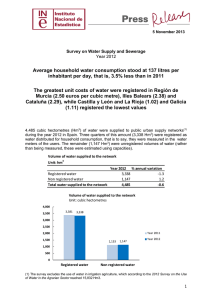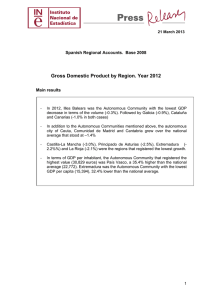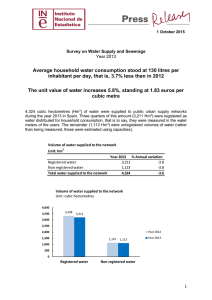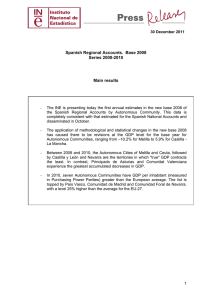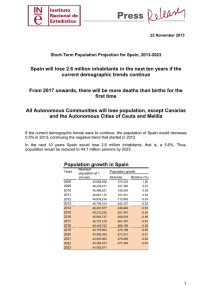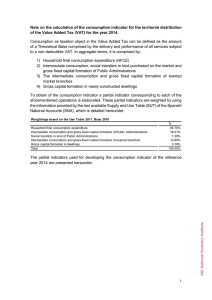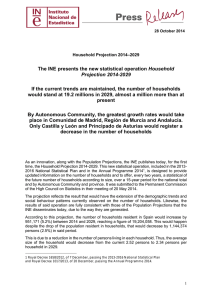Projected population of Spain 2014-2064
Anuncio
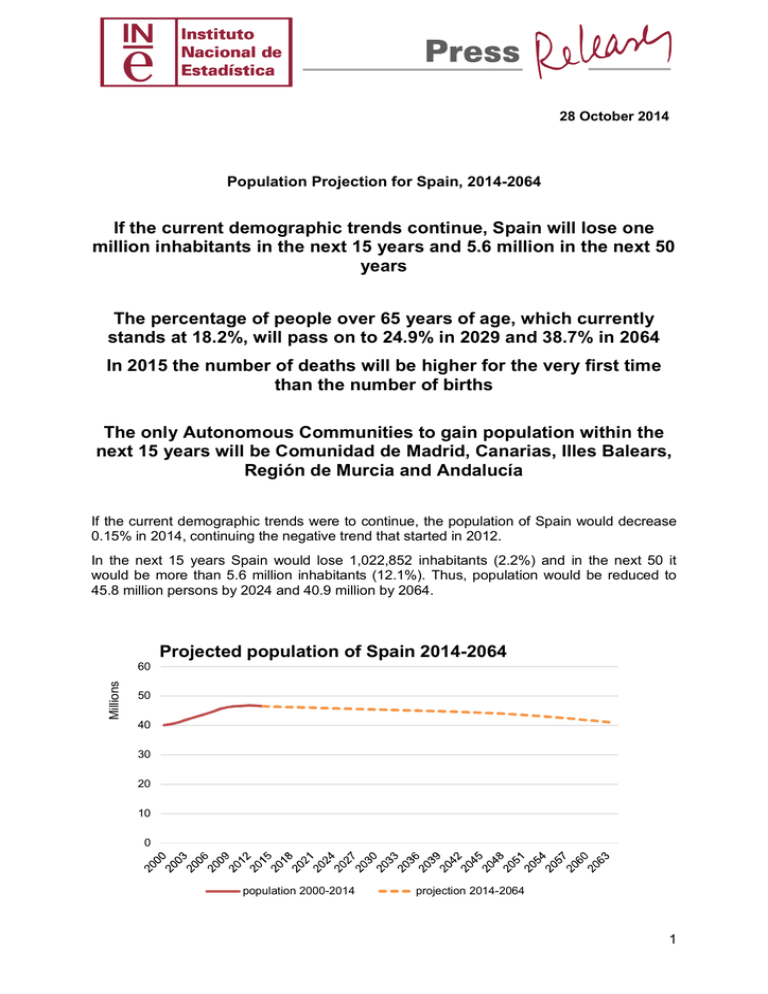
28 October 2014 Population Projection for Spain, 2014-2064 If the current demographic trends continue, Spain will lose one million inhabitants in the next 15 years and 5.6 million in the next 50 years The percentage of people over 65 years of age, which currently stands at 18.2%, will pass on to 24.9% in 2029 and 38.7% in 2064 In 2015 the number of deaths will be higher for the very first time than the number of births The only Autonomous Communities to gain population within the next 15 years will be Comunidad de Madrid, Canarias, Illes Balears, Región de Murcia and Andalucía If the current demographic trends were to continue, the population of Spain would decrease 0.15% in 2014, continuing the negative trend that started in 2012. In the next 15 years Spain would lose 1,022,852 inhabitants (2.2%) and in the next 50 it would be more than 5.6 million inhabitants (12.1%). Thus, population would be reduced to 45.8 million persons by 2024 and 40.9 million by 2064. Projected population of Spain 2014-2064 Millions 60 50 40 30 20 10 0 population 2000-2014 projection 2014-2064 1 Projected population resident in Spain 2014-2064 Year Population resident Population growth (*) on 1 January Absolute Relative (%) 2008 45,668,938 570,332 1.25 2009 46,239,271 247,350 0.53 2010 46,486,621 180,554 0.39 2011 46,667,175 151,041 0.32 2012 46,818,216 -90,326 -0.19 2013 46,727,890 -220,130 -0.47 2014 46,507,760 -70,964 -0.15 2015 46,436,797 -67,558 -0.15 2019 46,171,990 -52,961 -0.14 2024 45,829,722 -68,963 -0.15 2029 45,484,908 -66,002 -0.15 2034 45,154,897 -66,403 -0.15 2039 44,822,879 -77,580 -0.17 2044 44,434,981 -112,472 -0.25 2049 43,872,621 -159,507 -0.36 2054 43,075,084 -203,018 -0.47 2059 42,059,994 -235,232 -0.56 2064 40,883,832 (*) 2008-2013: Final Population numbers. From 2019, average annual grow th for every 5 years. Annual growth of the population of Spain 2000-2013 and according to the 2014-2064 projection 1,000,000 800,000 600,000 400,000 200,000 0 2064 2059 2054 2049 2044 2039 2034 2029 2024 2019 2014 2009 2004 -400,000 1999 -200,000 2 The reduction of resident population is mainly due to the progressive increase of deaths and the decrease of births, which is a phenomenon that will be particularly pronounced from 2040 on. Therefore, the natural growth would become negative as of the second year of the projection (2015), with a total of eight million persons in the 50 years projected. This negative growth would not be offset by the migratory balance, which would be positive for the same period with around 2.5 million net foreign migrations. Natural growth: births and deaths Following the trend started in 2009, the number of births in Spain would continue to decrease in the next years. Thus, around 5.1 million children would be born between 2014 and 2028, 24.8% less than in the previous 15 years. In 2029, the annual birth figure would be down to 298,202, 27.1% less than at present. This projection expects fertility to maintain a slightly declining trend. Therefore, the average number of children per woman would be 1.24 in 2029 and 1.22 at the end of the projected period, as compared with the current 1.27. Projected evolution of fertility rate by age Births by 1000 women 100 80 60 40 20 0 15 16 17 18 19 20 21 22 23 24 25 26 27 28 29 30 31 32 33 34 35 36 37 38 39 40 41 42 43 44 45 46 47 48 49 Age 2002 2014 2038 2063 The average age at childbearing, which currently stands at 31.7 years of age, would continue to rise gradually up to 33 years at the end of the period. The decrease in births would be mainly caused by the reduction in the number of women at child-bearing age. In fact, the number of women between the ages of 15 and 49 would be reduced by 1.9 million (17.4%) in 15 years and by 4.3 million in 50 years (39.2%). In turn, life expectancy at birth would reach 84.0 years old for males and 88.7 for females in 2029, resulting in an increase of 4.0 years and 3.0 years respectively, as compared with current values. If the current trend continued, in 2064 the life expectancy for men would exceed 91 years and for women it would almost reach 95 years. Likewise, a woman aged 65 years in 2064 would live an average of 30.8 years more (27.4 for men), as compared to the current 22.9 survival years (19.0 for men). 3 Projected life expectancy at birth and at 65 years old Life expectancy at 65 Life expectancy at birth years old Men Women Men Women 79.99 85.61 18.97 22.92 80.03 85.66 19.00 22.96 81.43 86.70 19.93 23.86 82.75 87.71 20.85 24.75 83.99 88.68 21.76 25.62 85.17 89.62 22.65 26.46 86.29 90.53 23.53 27.28 87.36 91.39 24.38 28.08 88.37 92.22 25.21 28.84 89.33 93.01 26.01 29.56 90.25 93.75 26.78 30.25 90.95 94.32 27.37 30.77 Year 2013 2014 2019 2024 2029 2034 2039 2044 2049 2054 2059 2063 Life expectancy at birth 95 90 85 80 75 Men 2063 2059 2055 2051 2047 2043 2039 2035 2031 2027 2023 2019 2015 2011 2007 2003 1999 1995 1991 70 Women Life expectancy at 65 years old 35 30 25 20 Men 2063 2059 2055 2051 2047 2043 2039 2035 2031 2027 2023 2019 2015 2011 2007 2003 1999 1995 1991 15 Women 4 Despite the loss of population and the improvements in life expectancy, the number of deaths would continue with its growing trend, due to the progressive ageing of the population. Thus, in the 2014-2029 period, more than six million deaths would be registered, 7.1% more than those recorded along the previous 15 years (1999-2013). In the year 2029 there would be 412,685 deaths among residents in Spain, and in 2063 the figure would reach 559,858 deaths (as compared with 395,163 in 2014). The decrease in births and the ageing of the population would lead to the registration of more deaths than births in Spain in 2015. In other words, the natural growth would turn negative. Natural growth of population of Spain 700 600 500 400 200 100 0 -100 -200 Births Deaths 2062 2060 2058 2056 2054 2052 2050 2048 2046 2044 2042 2040 2038 2036 2034 2032 2030 2028 2026 2024 2022 2020 2018 2016 2014 2012 2010 2008 2006 -400 2004 -300 2002 Milliards 300 Natural Growth Projected natural growth for population in Spain Years 2008 2009 2010 2011 Natural Births Defunciones Growth 518,503 384,198 134,305 493,717 383,209 110,508 485,252 380,234 105,018 470,553 386,017 84,536 2012 453,348 401,122 52,226 2013 2014 2018 2023 2028 2033 2038 2043 2048 2053 2058 2063 424,096 408,902 358,660 316,432 299,279 299,440 305,839 301,562 279,777 254,289 237,394 229,435 387,915 395,196 401,028 406,885 411,392 421,555 437,661 459,247 485,782 512,034 539,722 559,858 36,181 13,706 -42,368 -90,453 -112,113 -122,115 -131,822 -157,685 -206,005 -257,745 -302,328 -330,423 Source: 2002-2013, Statistics on the National Population Movement (provisional data for 2013) 5 Migratory growth According to the latest available information, the immigration flow in 2014 would reach a level of 332,522 immigrants, 14.3% more than in 2013. However, 417,191 persons would leave our country this year in order to reside abroad. As a result, Spain would register once again a negative foreign migratory balance for the fifth consecutive year, standing at –84,669 persons in 2014. The projection for the 2014-2063 period group is made on the hypothetical basis of a constant immigration flow and a trend of the population to migrate abroad, by ages, also constant, both of them held at their level forecasted for 2014 with the information currently available. If so, Spain would lose more than 275,000 inhabitants until year 2020 due to its population exchanges with foreign countries. Nevertheless, this trend would reverse from year 2021 on, with more entrances than exits, which would mean a net population gain of almost 2.5 million persons due to migrations in the next 50 years. Projected external Spanish migration Year Immigrations Emigrations Migratory Balance 2009 392,963 380,118 12,845 2010 360,704 403,379 -42,675 2011 371,335 409,034 -37,698 2012 304,054 446,606 -142,552 2013 291,041 547,890 -256,849 2014 332,522 417,191 -84,669 2015 332,522 398,908 -66,386 2018 332,522 356,025 -23,503 2023 332,522 311,885 20,637 2028 332,522 288,152 44,370 2033 332,522 275,733 56,789 2043 332,522 262,809 69,713 2053 332,522 253,082 79,440 2063 332,522 245,903 86,619 Source: 2008-2013, Migration Statistics (2013 is provisional); Projected external migration 700,000 600,000 500,000 400,000 300,000 200,000 100,000 0 -100,000 -200,000 2008 2010 2012 2014 2016 2018 2020 2022 2024 2026 2028 2030 2032 2034 2036 2038 2040 2042 2044 2046 2048 2050 2052 2054 2056 2058 2060 2062 -300,000 Immigration Emigration Migratory balance 6 Population by age group The conducted simulation also shows the intensity of the ageing process of the population resident in Spain, now accelerated by the decrease in the birth rate which is not offset by the positive migratory balance. If the current demographic situation remains, the loss of population will be concentrated in the age bracket between 30 and 49 years, which would register a decrease of 1.1 million persons in the next 15 years (28.2% less) and 6.8 million in the next 50 years (45.3% less). Moreover, the decrease in the birth rate would lead to a reduction of nearly 1,576,000 children under 10 years old in 2029 (32.8% less) and 2.3 million in 50 years (48.9% less), as compared with the present time. In turn, population would increase in the upper half of the population pyramid. In fact, all age groups over 70 years old would register a growth. In particular, in 15 years there will be 11.3 million persons 64 years old and over in Spain, 2.9 million more than in the present time (34.1%). This figure would increase up to 15.8 million persons (87.5% more) in 50 years. If we look at the five-year age groups, the largest of them at present time is 34 to 39 years old. In 2029 it would be 50 to 54 years old group and in 2064 the 85 to 89 years old group. 7 Projected population resident in Spain by age group in 2029 and 2064 Age groups 2014 2029 TOTAL Growth 20142019 2064 Growth 20142064 46,507,760 45,484,908 -1,022,852 40,883,832 -5,623,929 0 to 4 years 2,320,408 1,538,899 -781,508 1,183,906 -1,136,502 5 to 9 years 2,478,051 1,683,643 -794,408 1,268,878 -1,209,173 10 to 14 years 2,267,636 1,939,731 -327,905 1,403,355 -864,281 15 to 19 years 2,140,719 2,346,235 205,516 1,584,732 -555,988 20 to 24 years 2,374,582 2,603,060 228,479 1,762,097 -612,484 25 to 29 years 2,747,345 2,478,517 -268,828 1,862,348 -884,997 30 to 34 years 3,453,158 2,344,638 -1,108,520 1,900,872 -1,552,286 35 to 39 years 4,030,930 2,477,885 -1,553,046 1,955,583 -2,075,347 40 to 44 years 3,857,831 2,703,299 -1,154,532 2,079,058 -1,778,773 45 to 49 years 3,689,432 3,271,994 -417,439 2,284,925 -1,404,507 50 to 54 years 3,333,708 3,775,515 441,807 2,588,052 -745,656 55 to 59 years 2,878,297 3,592,907 714,610 2,705,302 -172,995 60 to 64 years 2,492,775 3,402,779 910,005 2,475,500 -17,275 65 to 69 years 2,328,239 3,031,281 703,042 2,270,596 -57,643 70 to 74 years 1,810,582 2,549,479 738,897 2,309,811 499,229 75 to 79 years 1,652,850 2,085,393 432,543 2,400,333 747,483 80 to 84 years 1,403,770 1,727,781 324,011 2,696,784 1,293,014 85 to 89 years 825,438 1,058,223 232,785 2,713,332 1,887,894 90 to 94 years 333,187 589,589 256,403 1,934,964 1,601,777 95 to 99 years 75,270 237,579 162,309 1,130,629 1,055,359 100 and more 13,551 46,480 32,929 372,775 359,224 Demographic ageing The percentage of population aged 65 years and over, which currently stands at 18.2% of the population, would pass on to 24.9% in fifteen years (in 2029) and to 38.7% in fifty years (in 2064). If the current demographic trends were to continue, the dependency rate (which is the quotient, as a percentage, of the population under 16 years old or over 64 years old and the population aged 16 to 64 years old) would increase more than seven points, from the current 52.1% to 59.2% in 2029. And it would be 95.6% in 2064. Hundred-year-old population (those persons aged 100 years and over) would pass from the current 13,551 persons to more than 372,000 in 50 years. Projected dependency ratio Year Older than 64 years old (%) 2010 2011 2012 2013 2014 2019 2024 2029 2039 2049 2059 2064 24.9 25.5 26.1 26.7 27.6 30.7 34.4 39.6 55.4 72.7 76.2 75.7 Younger than 16 years old (%) 23.5 23.8 24.1 24.3 24.6 24.0 21.9 19.6 19.5 21.9 20.9 19.9 Total (younger than 16 and older than 64) (%) 48.4 49.3 50.1 51.0 52.1 54.7 56.2 59.2 74.8 94.6 97.1 95.6 8 Population projections by Autonomous Community (2014-2029) If the current demographic trends were to continue, the loss of population would be registered in almost all Autonomous Communities in the next 15 years. The greatest decreases in relative terms would be registered in Castilla y León (–9.0%), Principado de Asturias (–8.3%) and Galicia (–7.6%). In turn, population would increase in Comunidad de Madrid, Canarias, Illes Balears and the Autonomous Cities of Ceuta and Melilla. Comunidad Foral de Navarra (–0.2%), Andalucía (0.0%) and Región de Murcia (0.1%) would almost maintain the same population size that at present time. Projected absolute growth by Autonomous Community2014-2029 107,844 Madrid, Comunidad de Canarias Balears, Illes Melilla Ceuta Murcia, Región de Andalucía Navarra, Comunidad Foral de Rioja, La Cantabria Castilla - La Mancha Extremadura Aragón Asturias, Principado de País Vasco Galicia Cataluña Castilla y León Comunitat Valenciana 60,807 53,987 10,773 7,133 893 274 -993 -16,862 -24,199 -29,937 -44,638 -57,140 -87,968 -109,209 -207,472 -222,317 -223,998 -239,830 -300000 -250000 -200000 -150000 -100000 -50000 0 50000 100000 150000 Projected relative growth by Autonomous Community 2014-2029 12.9 Melilla Ceuta Balears, Illes Canarias Madrid, Comunidad de Murcia, Región de Andalucía Navarra, Comunidad Foral de Castilla - La Mancha Total nacional Cataluña Extremadura Cantabria Aragón Comunitat Valenciana País Vasco Rioja, La Galicia Asturias, Principado de Castilla y León 8.4 4.8 2.9 1.7 0.1 0.0 -0.2 -1.4 -2.2 -3.0 -4.1 -4.1 -4.3 -4.8 -5.0 -5.4 -7.6 -8.3 -9.0 -15 -10 -5 0 5 10 15 9 Projected population growth by Autonomous Community Resident population on 1st January 2002 2014 2029 Total national 41,035,271 Andalucía 7,391,401 Aragón 1,209,917 Asturias, Principado de 1,062,796 Balears, Illes 845,130 Canarias 1,703,846 Cantabria 536,289 Castilla y León 2,454,840 Castilla - La Mancha 1,763,493 Cataluña 6,380,503 Comunitat Valenciana 4,192,287 Extremadura 1,057,795 Galicia 2,696,818 Madrid, Comunidad de 5,478,405 Murcia, Región de 1,206,619 Navarra, Comunidad Foral de 557,454 País Vasco 2,082,911 Rioja, La 277,993 Ceuta 70,874 Melilla 65,901 46,507,760 8,390,723 1,331,943 1,058,976 1,115,374 2,114,989 587,686 2,495,765 2,076,833 7,411,869 4,963,027 1,096,951 2,747,207 6,368,706 1,461,876 636,629 2,166,184 314,829 84,524 83,669 45,484,908 8,390,998 1,274,803 971,009 1,169,361 2,175,795 563,487 2,271,767 2,046,895 7,189,552 4,723,196 1,052,313 2,539,735 6,476,551 1,462,769 635,636 2,056,975 297,967 91,656 94,442 Absolute 2002-2014 5,472,489 999,322 122,026 -3,820 270,244 411,143 51,397 40,925 313,340 1,031,366 770,740 39,156 50,389 890,301 255,258 79,175 83,273 36,836 13,650 17,768 2015-2029 -1,022,852 274 -57,140 -87,968 53,987 60,807 -24,199 -223,998 -29,937 -222,317 -239,830 -44,638 -207,472 107,844 893 -993 -109,209 -16,862 7,133 10,773 Relative (%) 2002-2014 2015-2029 13.3 13.5 10.1 -0.4 32.0 24.1 9.6 1.7 17.8 16.2 18.4 3.7 1.9 16.3 21.2 14.2 4.0 13.3 19.3 27.0 -2.2 0.0 -4.3 -8.3 4.8 2.9 -4.1 -9.0 -1.4 -3.0 -4.8 -4.1 -7.6 1.7 0.1 -0.2 -5.0 -5.4 8.4 12.9 In three out of the 17 Autonomous Communities, the accumulated number of births would exceed that of deaths in the next 15 years. Thus, the natural growth between 2013 and 2022 would be positive in Illes Balears, Comunidad de Madrid and Región de Murcia. The Autonomous Cities of Ceuta and Melilla would also record positive natural growth in the next 15 years. 10 Natural increase 2014-2029 per thousand persons Melilla Ceuta Murcia, Región de Madrid, Comunidad de Balears, Illes Andalucía Navarra, Comunidad Foral de Cataluña Castilla - La Mancha Canarias Total Nacional Comunitat Valenciana Rioja, La Extremadura Aragón País Vasco Cantabria Castilla y León Galicia Asturias, Principado de 145.3 86.0 19.9 14.0 6.1 -2.0 -12.6 -13.3 -14.6 -16.3 -21.0 -28.5 -36.2 -41.1 -45.1 -48.0 -55.8 -84.2 -88.5 -106.3 Natural increase projected by Autonomous Community 2011 2012 2013 2014 2016 2026 2028 TOTAL 84,536 52,226 36,181 13,706 Andalucía 23,850 18,014 15,666 13,088 8,186 -9,315 -11,169 -943 -1,744 -1,689 -2,398 -3,038 -4,563 -4,550 -4,896 -5,529 -6,051 -6,157 -6,575 -7,656 -7,650 Balears, Illes 3,597 2,934 2,861 2,400 1,743 -692 -960 Canarias 3,858 3,120 2,199 1,561 300 -4,794 -5,474 Aragón Asturias, Principado de Cantabria Castilla y León Castilla - La Mancha Cataluña Comunitat Valenciana Extremadura -15,634 -105,814 -112,113 -262 -748 -766 -1,174 -1,534 -2,652 -2,711 -7,213 -9,213 -9,603 -10,805 -11,837 -14,490 -14,506 3,311 1,331 932 342 -608 -3,135 -3,254 21,059 14,461 11,010 7,306 1,574 -12,854 -13,301 8,658 5,271 3,680 417 -3,250 -14,246 -15,086 -646 -1,924 -2,144 -2,049 -2,374 -3,444 -3,566 Galicia -8,285 -9,782 -10,701 -11,741 -13,073 -17,774 -18,048 Madrid, Comunidad de -2,163 30,409 26,575 22,977 18,610 14,066 -970 Murcia, Región de 7,211 6,002 6,007 4,757 3,678 475 248 Navarra, Comunidad Foral de 1,589 1,355 780 534 99 -1,028 -1,048 País Vasco 1,323 252 -613 -2,313 -4,036 -9,017 -9,206 Rioja, La 287 165 31 -169 -405 -999 -1,021 Ceuta 651 641 558 565 542 487 489 Melilla 978 1,045 1,047 932 907 858 865 Source: 2010-2013 Vital Statistics (provisional data for 2013); If the current trend continues, the foreign migratory balance regarding size between 2014 and 2029 would be positive in ten Autonomous Communities, particularly in Canarias, Illes Balears and Principado de Asturias. 11 At the opposite end, worth noting would be population decreases due to foreign migrations in Región de Murcia, Comunitat Valenciana and Comunidad de Madrid, as well as in the Autonomous City of Melilla. Projected migratory balance 2014-2029 per thousand persons Canarias 51.2 Balears, Illes 16.3 Asturias, Principado de 15.9 Cantabria 13.6 Andalucía 12.0 Castilla y León 9.9 Aragón 5.7 Extremadura 3.7 Galicia 2.0 Navarra, Comunidad Foral de 2.0 Ceuta -0.4 Total Nacional -1.1 Castilla - La Mancha -3.6 Rioja, La -7.4 País Vasco -11.6 Cataluña -12.0 Madrid, Comunidad de -15.8 Comunitat Valenciana -17.7 Murcia, Región de Melilla -22.5 -42.9 Projected migratory balances abroad by Autonomous Community 2011 2012 2013 -142,552 -256,849 -84,669 -50,273 36,656 44,370 15,413 3,489 -11,397 2,856 4,220 8,983 9,541 -203 -3,188 -4,472 -948 -451 1,348 1,566 Asturias, Principado de 1,506 -119 -1,892 445 673 1,424 1,503 Balears, Illes 1,418 2,070 -2,586 -171 314 2,081 2,300 11,494 12,408 4,938 6,593 6,861 7,828 7,942 385 -1,035 -1,389 14 212 792 847 1,209 -2,291 -4,729 -698 187 2,761 3,018 58 -5,898 -9,172 -2,291 -1,672 563 839 -30,536 -45,432 -77,873 -30,984 -19,680 5,732 7,669 -5,132 -26,672 -29,187 -16,422 -12,137 -128 1,078 924 -61 -798 -154 -5 507 567 Total nacional Andalucía Aragón Canarias Cantabria Castilla y León Castilla - La Mancha Cataluña Comunitat Valenciana Extremadura Galicia -37,698 2014 2016 2026 2028 2,422 -931 -3,902 -1,254 -650 1,257 1,478 -21,745 -50,960 -83,834 -28,483 -18,858 3,316 5,029 Murcia, Región de -6,343 -6,903 -7,711 -4,771 -3,815 -762 -420 Navarra, Comunidad Foral de -1,350 -3,061 -3,004 -1,266 -652 691 786 País Vasco -7,868 -11,184 -13,663 -5,773 -3,853 199 471 -381 -2,166 -3,521 -1,060 -657 273 346 Madrid, Comunidad de Rioja, La Ceuta 587 18 -989 -18 -18 13 18 Melilla 444 -634 -1,669 -285 -294 -221 -208 12 Concerning internal migration, Illes Balears, Comunidad de Madrid and the Autonomous City of Melilla would be the territories which, regarding their size, would draw more population from the rest of Spain. On the contrary, Castilla y León, La Rioja and Andalucía would register the most negative migration balances between Autonomous Communities. Migratory balances among Autonomous Community 2014-2029 per thousand persons Balears, Illes 24.8 Madrid, Comunidad de 18.8 Melilla 17.3 Navarra, Comunidad Foral de 9.1 Galicia 8.2 País Vasco 8.1 Asturias, Principado de 3.8 Castilla - La Mancha 3.8 Murcia, Región de 3.3 Cantabria 0.3 Comunitat Valenciana -3.2 Extremadura -4.1 Aragón -4.4 Cataluña -5.1 Ceuta -5.3 Canarias -6.7 Andalucía -9.9 Rioja, La -11.6 Castilla y León -19.9 Natural increase projected between communities by Autonomous Community 2011 2012 2013 2014 2016 2026 2028 Andalucía -2,976 -6,153 -7,165 -5,441 -5,641 -5,513 -5,495 Aragón -1,013 -549 -193 -333 -402 -349 -321 Asturias, Principado de 150 -855 -838 -41 69 419 441 Balears, Illes 257 4,396 5,002 2,945 2,465 1,442 1,370 -1,106 3,777 3,154 -612 -796 -1,089 -1,084 63 -567 -175 -116 -70 77 84 -5,248 -7,623 -8,316 -5,118 -4,441 -1,971 -1,671 Canarias Cantabria Castilla y León Castilla - La Mancha 446 -6,978 -9,475 876 636 477 533 Cataluña -1,048 -3,100 -1,825 -3,181 -2,687 -2,302 -2,295 Comunitat Valenciana -2,524 -1,229 312 -1,999 -1,639 -500 -370 -253 -1,389 -1,035 -722 -610 16 104 Extremadura Galicia Madrid, Comunidad de Murcia, Región de Navarra, Comunidad Foral de País Vasco Rioja, La 711 768 -53 624 889 1,954 2,099 7,728 13,520 15,138 10,220 9,739 6,398 5,897 -467 959 1,572 646 497 180 148 986 632 -79 585 536 245 205 3,375 3,243 3,255 1,534 1,418 872 797 -443 -311 -322 -488 -367 -126 -109 Ceuta 261 39 372 173 98 -154 -203 Melilla 1,098 1,422 673 448 306 -77 -131 13 Methodological note The Population Projection for Spain compiled by the INE constitutes a statistical simulation of the demographic size and structure of the population resident in Spain in the next 50 years, and in its Autonomous Communities and provinces during the forthcoming 15 years, should the currently observed demographic trends and behaviour continue. In this way, these results basically show the effect that the recently observed evolution of fertility, mortality and migrations would have, in the immediate future, in each one of these territories. In the last years, the INE used to release every year one short-term population projection (for the following 10 years) and one long-term population projection every three years (for the following forty years). In this edition we have decided to join them both in one single operation that will be released every two years, providing data for the following 50 years for the total national and for the following 15 years for Autonomous Communities and provinces. This edition covers the 2014-2064 and 2014-2029 periods, respectively. As the projection ends with population on 1 January 2064, the involved demographic phenomena (births, deaths, etc.) are calculated only up to 2063, included. In order to prepare the population projection we start from a series of evolution hypothesis for each one of the basic demographic phenomena that determine the volume and structure of it: fertility, mortality and migrations. In the case of fertility and mortality, the projection for the forthcoming 50 years is that of the trend observed in the 10 last years. Concerning the immigration from foreign countries, the inflow observed in the last year remains constant while in the case of outward and interprovincial migration the emigration intensity (the tendency of the population to emigrate) of the last year observed remains constant. The objective is showing the future evolution of the size and structure of the population that will reside in Spain in the coming years, should the currently observed demographic trends and behaviour continue. The National Statistics Institute is now disseminating the results of the Short-Term Population Projection for Spain, 2013-2023. The general calculation methodology is based on the classical component method. The application of the said method is in response to the following schema: starting from the resident population in a certain geographical area, and the retrospective data observed for each one of the basic demographic components (mortality, fertility and migration), the idea is to obtain the figures on the resident population, corresponding to subsequent dates, under the hypotheses established on the development of these three phenomena, which are those which determine their growth and their structure by age. The component method has been applied according to a multiregional projection model which enables the total consistency of results at all territorial levels considered, and the coherence necessary between demographic flows and population stocks. 14 Reference date of the results For the total national it is 1st January of each year of the 2014-2064 period for population stocks; annual demographic flows of the 2014-2063 period for demographic events. For Autonomous Communities and provinces it is 1st January of each year of the 2014-2029 period for population stocks; annual demographic flows of the 2014-2028 period for demographic events. Population scope: the population resident in Spain and in each of its Autonomous Communities and provinces. Territorial scope: Spain, Autonomous Communities and provinces. Breakdown variables: sex, age and generation, for both population stocks and demographic events. Entry population: the Population figures at 1st January 2014 (provisional data). For further information see INEbase-www.ine.es/en/ All press releases at: www.ine.es/en/prensa/prensa_en.htm Press Office: Telephone numbers: 91 583 93 63 / 94 08 – Fax: 91 583 90 87 - [email protected] Information Area: Telephone number: 91 583 91 00 – Fax: 91 583 91 58 – www.ine.es/infoine/?L=1 15
